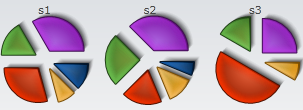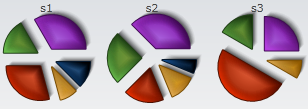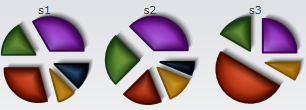Value
Result
BorderStyle.Light

BorderStyle.Combo

BorderStyle.Dark

Border Effects
You can control the light angle, saturation, and transparency of the light source of the data series using the BorderEffects class. The BorderEffects class includes the follow properties:
Property | Description |
Gets or sets the border style. | |
LightAngle | Gets or sets the light direction. |
Gets or sets the thickness of the border. |
BorderStyle Property
You can achieve a brightening or darkening effect on the data series using the BorderEffect.BorderStyle property. The BorderEffect.BorderStyle property provides three options: light, dark, and combo. The Light value will make the current data series color appear lighter in color. The Dark value produces a dark color effect for the current data series color. The Combo value produces a combination of the light and dark values for the current data series color.
The following table illustrates the effects of each value for the BorderEffect.BorderStyle property:
Value | Result |
BorderStyle.Light |
|
BorderStyle.Combo |
|
BorderStyle.Dark |
|
LightAngle Property
You can change the angle of the visual rendering within the data series by setting its LightAngle property to a different degree. The value of the LightAngle property ranges from -180 to 180 degrees.
The following table illustrates the data series with a LightAngle value of 53 degrees and the data seires with a no LightAngle applied to it:
Value | Result |
53 degree angle |
|
None |
|
Thickness Property
As you increase the Thickness, the light source within each series gradually decreases. When the Thickness property is set to a value higher than 25 the gradient light effects are not as noticeable.
The following table illustrates the effects of the various values for the BorderEffect.Thickness property:
Numerical Value | Result |
0 |
|
10 |
|
25 |
|